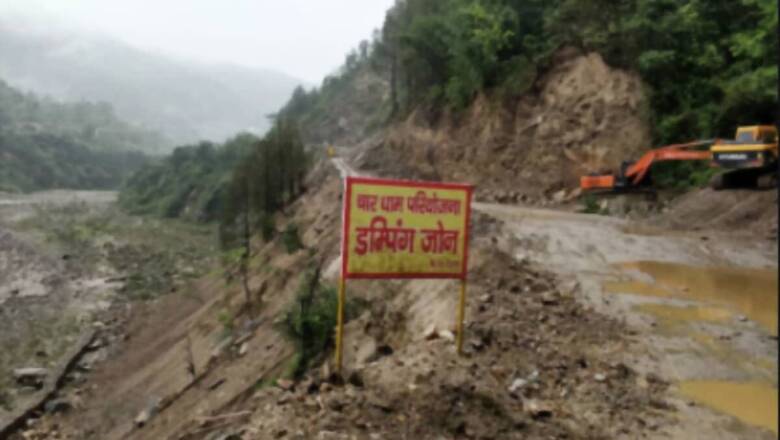
views
New Delhi: The Narendra Modi-led government’s flagship Char Dham all-weather road project that seeks to widen road connectivity in Uttarakhand has come under spotlight once again. The Supreme Court constituted high-powered committee (HPC), which is reviewing ecological concerns related to the project activities, recently submitted its report to the apex court. Further, HPC chairman Ravi Chopra also wrote a letter to the Secretary, Ministry of Environment, Forest and Climate Change detailing alleged lapses in compliance of forest rules and wildlife laws.
The Char Dham Highway project involves widening of 900 kilometers of national highways connecting the four holy Hindu pilgrimage sites of Badrinath, Kedarnath, Gangotri and Yamunotri at an estimated cost of over Rs 12,000 crore. As part of the project, roads will be widened from 10m to 24m. The project also involves construction of tunnels, bypasses, bridges, subways and viaducts.
The HPC chairman Ravi Chopra, former director of People’s Science Institute, Dehradun, speaks to News18 about the alleged procedural lapses and ecological concerns related to the Char Dham project as well as the Bhagirathi Eco-Sensitive Zonal Master Plan which will regulate developmental works in the fragile 100-km stretch between Gaumukh and Uttarkashi town.
You recently wrote to the union environment and forest secretary on violations of forest and wildlife laws in the Chardham all-weather road project. What did the high-powered committee see during their ground visit?
When we were on our field tours, we noticed that on NH-125 Tanakpur to Pithoragarh and also on NH-58 bet Karnprayag and Helang, at a lot of places muck was dumped down the slopes. It did not appear to us that these were authorised muck dumping sites, so we started asking questions and the DFO (Divisional Forest Officer) was with us on the tour through the district. The answers we got were that they were also unhappy about this happening because it was leading to loss of forest cover, endangering habitations downhill. In fact, the DFO, Chamoli, had fined the National Highways and Infrastructure Development Corporation Limited (NHIDCL), the implementing agency.
The committee looked into the matter further and found that there had been non-compliance of procedures in permitting non-forest activities. The scope of work had changed but the project authorities were using old clearances. These clearances were granted to Border Roads Organisation many years ago to widen NH-125 and NH-58. The current plan involves further widening of roads and is being executed by the Public Works Department and the NHIDCL. Earlier very little hill cutting and muck generation was to happen but now the muck generated was huge and they had no place to put it because they had not sought permissions. So they have dumped it at many unauthorised locations and this has been confirmed with the help of satellite imagery.
They used the old clearances given to BRO, which is not permitted by law. The rules of the Forest Conservation Act, 1980, do not permit it unless the scope of work remains same. At some places they have cut up to 24 metres width, which is the right of way.
What prompted you to say in your letter that it is as if there is no rule of law?
We checked many details and the DFOs said they had been threatened and warned. In one of the documents, the Uttarakhand State Forest Department wrote to the project proponent that… “Since Chardham project is related to the ambitious plan of Prime Minister Narendra Modi and considering the importance of project, tree felling in above listed 1-6 matters is completed without having any compliance report. Though without complying of in-principle approval such act is, in fact, in clear violation of the conditions of Government of India.”
We found several such procedural lapses which appear to us to be very serious violations. But since we did not have time to carry out a full investigation, we did not include them in our full report to the Supreme Court. However, the committee felt that these details should be forwarded to the Ministry of Environment, Forest and Climate Change with a request for them to investigate this matter and inform us of the outcome.
How will the project work affect the hill and rivers ecology of the region?
There are direct and indirect impacts. During the road construction process, even though the rules say you cannot dump any muck or debris into the river, very often it is done. Sometimes it is done as a result of a crisis situation such as landslide and they push the debris down into the river to clear the roads for the traffic. Sometimes it happens because the retaining wall is not strong. Now, when the muck and debris enter the river its turbidity increases. Several organisms that dwell on the bed of the river or flow with the water, including autotrophs, they convert carbon dioxide from the atmosphere and emit oxygen. They cannot carry out photosynthesis reaction and it affects the dissolved oxygen content, this is an example of a direct impact.
Indirect impact is that when you are cutting such large scale forests in hills, there are studies that suggest say that the special purification capacity of the Ganga is probably due to the vegetative matter and debris that rolls into the river from the slopes. Once the slopes are rendered barren, you are reducing the amount of material that is probably a major source of the special property of the Ganga.
On a separate but important matter for Uttarakhand, the government recently finalised the master plan to govern the Bhagirathi Eco-Sensitive Zone between Gaumukh and Uttarkashi. As a member of the NGT-appointed Experts Committee and the SC appointed Scrutiny Committee, what are your chief reservations about this plan?
The basic guiding principle enunciated in the gazette notification of 2012 was that the zonal master plan (ZMP) be prepared in close consultation with the local people, especially the women. In fact, the Chief Secretary had directed the district magistrate of Uttarkashi to carry out such consultations. There were only token consultations. It remains a compilation of departmental proposal based on current schemes. It remains similar to the October 2016 ZMP with selective inclusion of the comments and suggestions made by the committee members. The Experts Committee members did not sign the document submitted by the state government.
The ZMP that was discussed with us, it lacked a practical focus towards its basic objectives of ensuring ecological and livelihood security in the eco-sensitive zone.
Has the state government failed to represent the concerns on the ground in the ZMP?
Yes, many things are missing. The Uttarakhand government, Niti Aayog, have been talking of the drying up of springs. There is no data on the number of springs and streams in the BESZ which have dried up or are in a critical stage. There is nothing that discusses how these will be revived despite the advice of the experts. Their revival is absolutely critical for the well being of the river. Because, a large part of the annual flows in the river comes from base flows and recharge from the rainwater rather than the melting of the glaciers.
The only significant change they made was dropping of nine small hydropower projects which was something that was emphasised repeatedly by the members of the Experts committee appointed to help in drafting of the zonal master plan. These projects are prohibited by the BESZ notification of December 2012. Even in the April 2018 notification of amendments, that clause was retained. The central government refused to permit such small hydropower projects. So the state government had no choice but to drop the projects.

















Comments
0 comment